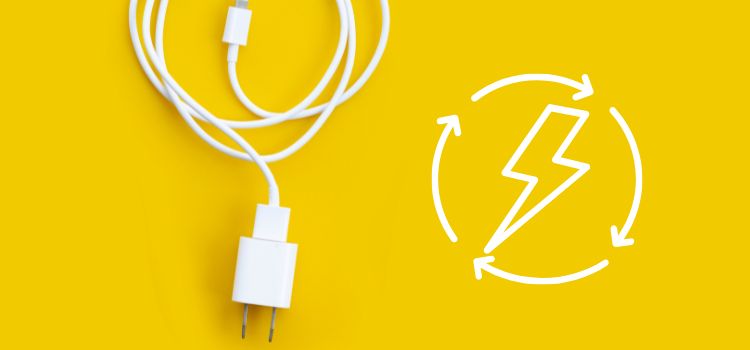As an Amazon Associate, I earn from qualifying purchases.
In the digital age, smartphones are an integral part of our daily life. Keeping these devices powered and ready for use is crucial, which makes understanding how phone chargers work an essential topic. One key aspect of a phone charger is its voltage. This article delves into the specifics of phone charger voltage, how it works, and why it matters.
The Basics of Voltage
The force that drives electric current through a circuit is voltage, sometimes called the electric potential difference. It is measured in volts (V). In phone chargers, voltage is critical as it determines how quickly and efficiently a phone’s battery can be charged. Most phone chargers convert the AC (alternating current) voltage from a wall outlet to a lower DC (direct current) voltage suitable for smartphone charging.
Standard Voltage for Phone Chargers

Most modern phone chargers operate at a standard output voltage of 5 volts (V). This standard was established with the advent of USB (Universal Serial Bus) charging technology, which has become the norm for charging various electronic devices, including smartphones, tablets, and other portable gadgets.
1. USB and Its Evolution
USB technology has evolved, developing various versions with different charging capabilities. Here’s a brief overview:
- USB 1.0 and 2.0: These older versions of USB provide a standard voltage of 5V with a maximum current of 0.5A (amperes), resulting in a power output of 2.5 watts (W).
- USB 3.0 and 3.1: These newer versions also provide a standard voltage of 5V but an increased current capacity of up to 0.9A, leading to a power output of 4.5W.
- USB-C and USB Power Delivery (USB PD): The introduction of USB-C connectors and USB PD technology has significantly changed the charging landscape. USB-C can support multiple voltages (5V, 9V, 12V, 15V, and 20V) and higher current levels (up to 5A), allowing power outputs as high as 100W. This flexibility enables faster charging times and supports a broader range of devices.
2. Fast Charging Technologies
As smartphones have become more advanced, so too have their charging requirements. Several fast-charging technologies have been developed to meet the demand for quicker charging times. These technologies often require higher voltages than the standard 5V:
- Qualcomm Quick Charge: This technology is widely used in Android devices. Quick Charge 2.0 supports 5V, 9V, and 12V, while Quick Charge 3.0 introduces dynamic voltage scaling, allowing the charger to adjust the voltage in 0.2V increments from 3.6V to 20V. Quick Charge 4.0 and later versions further enhance charging speed and efficiency.
- Apple Fast Charging: Apple devices, starting with the iPhone 8 and later, support fast charging using USB-C to Lightning cables. Depending on the power adapter, these chargers typically provide 9V at 2A (18W) or higher.
- Samsung Adaptive Fast Charging: Samsung’s proprietary fast charging technology supports 5V and 9V at higher currents, allowing for rapid charging of compatible devices.
- VOOC (Voltage Open Loop Multi-step Constant-Current Charging): Developed by OPPO, VOOC uses a lower voltage of 5V but increases the current to as much as 4A or 5A to achieve faster charging speeds without generating excessive heat.
3. Safety Considerations
When dealing with phone chargers and their voltages, safety is paramount. Using chargers that are not compatible with your device can result in inefficient charging or, worse, damage to your phone’s battery. Here are some safety tips:
- Use Manufacturer-Approved Chargers: Always use chargers and cables approved by the phone manufacturer. These are designed to work optimally with your device and adhere to safety standards.
- Avoid Cheap, Unbranded Chargers: Cheap chargers may seem appealing, but they sometimes lack adequate safety protections and risk overheating, short-circuiting, or even catching fire.
- Inspect Chargers Regularly: Check your chargers and cables for any signs of wear and tear. Damaged chargers can be dangerous and should be replaced immediately.
- Follow Manufacturer Guidelines: Adhere to the charging guidelines provided by your phone manufacturer to ensure safe and efficient charging.
Future Trends in Phone Charging
The technology behind phone chargers continues to evolve, with trends pointing towards even faster and more efficient charging solutions. Here are some emerging trends:
- Wireless Charging: Wireless charging technology, based on the Qi standard, enables users to charge their devices without a cable. Although it typically operates at lower power levels than wired charging, advancements are being made to increase its efficiency and speed.
- GaN (Gallium Nitride) Chargers: GaN technology enables the production of smaller and more efficient chargers that can handle higher power levels. These chargers are growing in popularity because they are small and portable and can charge devices quickly.
- Universal Fast Charging Standards: Efforts are being made to standardise fast charging technologies across different brands and devices. This would simplify the charging process and reduce the need for multiple chargers.
- Eco-Friendly Chargers: With growing environmental concerns, manufacturers focus on creating more sustainable and eco-friendly chargers. This includes the use of recyclable materials and energy-efficient designs.
Conclusion
Understanding phone chargers’ voltage and overall functionality is essential for ensuring your devices are charged safely and efficiently. While the standard voltage for most phone chargers is 5V, technological advancements have led to fast charging solutions operating at higher voltages and currents. As technology develops, we may anticipate more creative and effective charging options. Always prioritise safety by using manufacturer-approved chargers and following the recommended guidelines for your specific device. Doing so lets you keep your smartphone powered up and ready whenever needed.
This comprehensive piece covers the essential aspects of phone charger voltage, safety considerations, and emerging trends in the industry. It should be a valuable addition to your website, providing readers with a thorough understanding of the topic.
FAQs about Phone Chargers and Voltage

What voltage do most phone chargers use?
Most phone chargers use a standard voltage of 5 volts (V). This standard was established with USB (Universal Serial Bus) charging technology, commonly used for smartphones and other portable devices.
Can using a charger with a higher voltage damage my phone?
If you use a charger with a higher voltage than it is made for, your phone’s battery and other internal parts could be harmed. It’s essential to use a charger that matches the voltage specifications provided by the phone manufacturer or supports dynamic voltage scaling technologies like Qualcomm Quick Charge or USB Power Delivery (USB PD), which adjusts the voltage as needed.
What is fast charging, and how does it work?
Fast charging technology allows a phone to charge faster than standard charging. It typically involves higher voltages and currents. Technologies like Qualcomm Quick Charge, Apple Fast Charging, and USB Power Delivery (USB PD) enable fast charging by increasing the voltage (e.g., 9V, 12V, or higher) and current (e.g., 2A, 3A, or higher) delivered to the phone, reducing the overall charging time.
Are wireless chargers as efficient as wired chargers?
In general, wired chargers are more efficient than wireless chargers. Wireless charging involves energy transfer through electromagnetic fields, which can result in energy loss and slower charging speeds. However, The efficiency and charge speed of wireless charging technology are constantly being improved. Wired chargers with fast charging capabilities are usually preferred for the fastest charging.
Is it safe to use my phone with chargers from third parties?
While some third-party chargers can be safe and effective, choosing reputable brands that adhere to safety standards and are compatible with your phone’s charging specifications is crucial. Using cheap, unbranded chargers can pose risks such as overheating, short-circuiting, and potential damage to your phone. Whenever possible, use manufacturer-approved chargers to ensure safety and optimal performance.
Amazon and the Amazon logo are trademarks of Amazon.com, Inc, or its affiliates.